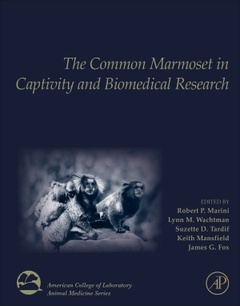The Common Marmoset in Captivity and Biomedical Research American College of Laboratory Animal Medicine Series
Coordonnateurs : Marini Robert P., Wachtman Lynn M., Tardif Suzette D., Mansfield Keith, Fox James G.

The Common Marmoset in Captivity and Biomedical Research is the first text dedicated exclusively to this species,filling an urgent need for an encyclopedic compilation of the existing information. Sponsored by the American College of Laboratory Animal Medicine as part of its authoritative Blue Book series, the book covers the biology,management, diseases, and clinical and research applications of this important species. The common marmoset (Callithrix jacchus) has come of age in the scientific community as a behaviorally complex, cognitively advanced,small, prolific, and easily maintained nonhuman primate with many of the advantages of larger animals, such as macaques, but without the attendant physical and zoonotic risks.
Marmosets are currently being used in diverse areas of inquiry, including vision and auditory research, infectious disease, cognitive neuroscience, behavior, reproductive biology, toxicology and drug development, and aging. The marmoset genome has been sequenced and there is currently an intensive effort to apply gene editing technologies to the species. The creation of transgenic marmosets will provide researchers with a small nonhuman primate model to study a number of poorly understood disorders, like autism.
Section I: BIOLOGY AND MANAGEMENT 1. Taxonomy and Natural History 2. The Anatomy of the Common Marmoset 3. Neuroanatomy of the Marmoset 4. Marmoset Nutrition and Dietary Husbandry 5. Husbandry and Housing of Common Marmosets 6. Normal Clinical and Biological Parameters of the Common Marmoset (Callithrix jacchus) 7. Behavior and Behavioral Management 8. Reproduction, Growth, and Development 9. Regulatory Considerations
Section II: DISEASES AND CLINICAL APPLICATIONS 10. Physical Examination, Diagnosis, and Common Clinical Procedures 11. Anesthesia and Common Surgical Procedures 12. Diseases of the Urogenital System 13. Diseases of the Gastrointestinal System 14. Bone, Muscle, and Skeletal Disease 15. Viral Diseases of Common Marmosets 16. Bacterial Diseases 17. Parasitic Diseases 18. Neoplastic Diseases
Section III: RESEARCH AND APPLICATIONS 19. The Genome of the Common Marmoset 20. Creating Genetically Modified Marmosets 21. Marmosets in Aging Research 22. The Marmoset Monkey as a Model for Visual Neuroscience 23. Marmosets in Neurologic Disease Research: Parkinson’s Disease 24. Experimental Autoimmune Encephalomyelitis in the Marmoset as a Translational Model for Multiple Sclerosis 25. Marmosets in Auditory Research 26. The Marmoset as a Model in Behavioral Neuroscience and Psychiatric Research 27. The Use of the Marmoset in Toxicity Testing and Nonclinical Safety Assessment Studies 28. Experimental Infections of the Common Marmoset (Callithrix jacchus) 29. Insights Gained from Marmoset Endocrine Research
vivarium professionals maintaining marmoset colonies, veterinarians responsible for their care and well-being, zoologists and ethologists studying the species, and investigators using them to gain critical insights into human physiology and disease.
Harvard Medical School, Boston MA USA
Suzette D. Tardif, Ph.D., is the Associate Director of Research at the Southwest National Primate Research Center. She is an adjunct faculty of The Barshop Institute. The Tardif laboratory's activities center on the development of the marmoset monkey as a disease model. Dr. Tardiff is a past-President of the American Society of Primatologists.
Keith Mansfield is Associate Director for Resource and Collaborative Affairs and Chair, Division of Primate Resources, New England National Primate Research Center, Harvard Medical School, Harvard University, Southborough, US. His research focuses on primarily on the recognition of spontaneously occurring infectious diseases of nonhuman primates and their development into novel animal models to investigate disease pathogenesis.
Prof. Fox obtained his Master of Science degree in Medical Microbiology at Stanford University and a Doctor in Veterinary Medicine at Colorado State University, Fort Collins. Dr. Fox is an Adjunct Professor at Tufts University School of Veterinary Medicine and the University of Pennsylvania, School of Veterinary Medicine. He is a Diplomate and a past president of the American College of Laboratory Animal Medicine, past president of the Massachusetts Society of Medical Research, past chairman of AAALAC Council, and past chairman of the NCCR/NIH Comparative Medicine Study Section. He also is an elected fellow of the Infectious Disease Society of America. In 2004 Professor Fox was elected to the Institute of Medicine of the National Academy of Sciences.
- Presents a complete view of the marmoset, covering their biology and management, diseases and clinical applications, and research applications
- Includes contributions from renowned and international authors and editors
- Provides the first authoritative and comprehensive treatment of marmosets in biomedical research as part of the ACLAM Series
Date de parution : 11-2018
Ouvrage de 570 p.
21.4x27.6 cm
Thème de The Common Marmoset in Captivity and Biomedical Research :
Mots-clés :
ABSL; Adrenal steroids; Albumin; Analgesia; Anatomy; Anesthesia; Annotation; Arthritis; Auditory cortex; Auditory system; Autoimmunity; Behavior; Behavioral models; Best practices; Biocontainment; Biomarkers of aging; Blood transfusion; Brain atlas; Cage; Callithrix jacchus; Callitrichidae; Callitrichine herpesvirus 1Common marmoset; Carbohydrates; Chimerism; Circadian rhythms; Circulatory system; Cognition; Common marmoset; Common marmosets; Comparative; Cooperative breeders; Cortical lesions; Cortisol; Cotton-top tamarins; Cross-species comparison; Diarrhea; Digestive system; Diseases; Dominance; Drug development; Embryonic and fetal loss; Embryonic stem cell; Endocrine organs; Enrichment; Epstein–Barr virus; Estrogen; Experimental infections; External characteristics; Fear/anxiety; Fibrous osteodystrophy; Flexibility; Gastrointestinal system; Glomerulonephropathy; Growth; Health span; Hearing; Hematology; Herpesvirus; Housing; Human model; Identification; Immunology; Induced pluripotent stem cell



